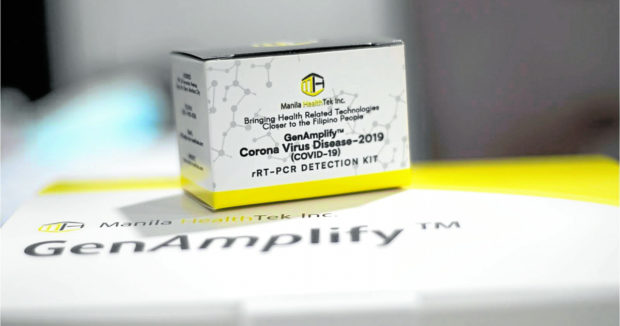
IDLE WATCHERS NO MORE “We all shared in the vision that someday, we will not just sit idly on the sidelines while our for- eign counterparts find solutions to our own health problems,’’ said Dr. Raul Destura, whose company now offers the first local- ly made COVID-19 testing kit. —PHOTO FROM MANILA HEALTHTEK INC.
MANILA, Philippines — As COVID-19 cases continue to surge more than a year since the new coronavirus was first detected in the Philippines, the research and development company that developed the country’s own reverse transcription-polymerase chain reaction (RT-PCR) swab testing kit finally opened its own testing center in Manila on Wednesday.
From its main testing laboratory in Marikina City, Manila HealthTek Inc. (MTek, Inc.) now has a COVID-19 swab station located in a parking area on M.H. Del Pilar Street in Ermita, Manila.
“For now, our main objective is to have better detection of those who are infected (with the virus) and to provide help to people who need to be tested,” said Ramzen Rosales, MTek’s director for business development.
Manila HealthTek’s testing kits — formally called GenAmplify — was first used in October 2020. At P2,950 per swab test, the locally developed test kit is relatively more affordable than other test kits that are priced at P4,000 to P8,000 each.
The cost has been trimmed down because Manila HealthTek uses its own materials, facilities and equipment to administer and process the tests, said Rosales.
“One of our goals is to provide testing for Filipinos at the lowest price possible. Since we are the only biotechnology company in the Philippines, we (can) make our own materials,” he added.
Results can be processed in 24 to 48 hours, while the testing site can accommodate up to 100 people a day. The swabbing station, which is open from 8:30 a.m. to 4:00 p.m. daily, also has enough health professionals on site, such as medical technologists and medical aides, to adequately attend to the testing needs of patients, Rosales said.
Open space
The MTek official said the Ermita location was chosen to cater specifically to employees of sea- and land-based manpower agencies that proliferate in the area. Seafarers and other worker-clients of these agencies may need a negative COVID-19 test result before they can be deployed overseas.
The location’s open space also assures the public of less chances of virus transmission, he added.
While walk-in patients are welcome, especially residents of the community who may not have internet access, Rosales said booking an online appointment through Manila HealthTek’s official Facebook page could prevent crowding in the facility.
He added that the swabbing station was also considering setting up a drive-thru testing facility to accommodate patients with comorbidities and to lessen the possible exposure of patients to the virus.
Willing to partner
As of Wednesday, its opening day, Manila HealthTek’s COVID-19 Swabbing Station has already received at least 25 bookings, with more inquiries about its testing services, the company’s official said.
Seeing that more people may require its services, Rosales said Manila HealthTek was open to establishing more testing sites in other parts of the country. It was also willing to partner with other companies for COVID-19 vaccination drives, he added.
“With the company’s direction (in mind), our main goal is to stop the spread of the coronavirus by extending our testing areas so we can detect cases and decrease the needed scope for contact tracing,” Rosales said.
As its founder/CEO Dr. Raul Destura said in the company’s website: “Over the last five years, our team has been silently working in the laboratory to find diagnostic solutions to diseases in which timely diagnosis could potentially save lives. We all shared in the vision that someday, we will not just sit on the sidelines while our foreign counterparts find solutions to our own health problems, but as Filipino scientists finding solutions to the health problems of our fellow Filipinos.”